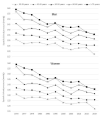Cardiovascular disease, a major global burden: Epidemiology of stroke and ischemic heart disease in Japan
- PMID: 35036616
- PMCID: PMC8692094
- DOI: 10.35772/ghm.2020.01113
Cardiovascular disease, a major global burden: Epidemiology of stroke and ischemic heart disease in Japan
Abstract
Japan ranks the highest globally, in terms of longevity. The average life expectancy was 81.4 years for men and 87.5 years for women in 2019. Such success in health is attributable to the substantial reduction in age-standardized mortality from cardiovascular diseases, especially stroke (136 per 105 in 1980 and 24 per 105 in 2015), when stroke mortality was the highest in the world between the 1960s and the 1990s. On the other hand, ischemic heart disease mortality was the lowest in the world between the 1960s and the 1980s and has continued to decline (40 per 105 in 1980 and 17 per 105 in 2015). Such a disease profile (larger burden of stroke compared to ischemic heart disease) was observed not only in Japan but also in some countries in central Asia and Africa, where small vessel disease (arteriolosclerosis) is assumed to be more common than large vessel disease (atherosclerosis). Between 1970 and 2015, a large decline in the population with high blood pressure levels was observed for both men and women. Meanwhile, there was a moderate decline in the smoking rate among men, and an increasing trend in serum cholesterol levels in both men and women. The sharp and extensive socioeconomic development between the 1960s and 1990s contributed to these health outcomes, while preventive measures and improved emergency medical care also contributed to the reduction of risk factors, disease incidence, case-fatality, and mortality. However, there is a threat of increasing incidence of ischemic heart disease in urban male employees and middle-aged male residents. Japan, with a super-aging society, needs to develop a new model for the prevention and control of cardiovascular disease and related health issues, with emphasis on efforts towards the early (primordial) prevention of cardiovascular disease as well as the attenuation of their progress towards chronic heart failure, chronic kidney disease, and vascular dementia.
Keywords: Japan; cardiovascular disease; epidemiology; pathology; prevention.
2021, National Center for Global Health and Medicine.
Conflict of interest statement
The authors have no conflicts of interest to disclose.
Figures






Similar articles
-
Prevention of cardiovascular disease, a major non-communicable disease, in a super-aging society: Health success and unsolved issues in Japan.Glob Health Med. 2024 Feb 29;6(1):33-39. doi: 10.35772/ghm.2023.01130. Glob Health Med. 2024. PMID: 38450114 Free PMC article. Review.
-
Cardiovascular disease epidemiology in Asia: an overview.Circ J. 2013;77(7):1646-52. doi: 10.1253/circj.cj-13-0702. Epub 2013 Jun 21. Circ J. 2013. PMID: 23803294 Review.
-
Lifestyle and cardiovascular disease in Japan.J Atheroscler Thromb. 2011;18(2):83-8. doi: 10.5551/jat.6866. Epub 2011 Feb 5. J Atheroscler Thromb. 2011. PMID: 21307610 Review.
-
Explanation for the Japanese paradox: prevention of increase in coronary heart disease and reduction in stroke.J Atheroscler Thromb. 2007 Dec;14(6):278-86. doi: 10.5551/jat.e529. Epub 2007 Dec 17. J Atheroscler Thromb. 2007. PMID: 18174657 Review.
-
A Japanese health success story: trends in cardiovascular diseases, their risk factors, and the contribution of public health and personalized approaches.EPMA J. 2011 Mar;2(1):49-57. doi: 10.1007/s13167-011-0067-0. Epub 2011 Mar 24. EPMA J. 2011. PMID: 23199126 Free PMC article.
Cited by
-
Burden of neurological diseases in Asia, from 1990 to 2021 and its predicted level to 2045: a Global Burden of Disease study.BMC Public Health. 2025 Feb 20;25(1):706. doi: 10.1186/s12889-025-21928-9. BMC Public Health. 2025. PMID: 39979885 Free PMC article.
-
Associations between Supper Timing and Mortality from Cardiovascular Disease among People with and without Hypertension.J Atheroscler Thromb. 2024 Jul 1;31(7):1098-1105. doi: 10.5551/jat.64192. Epub 2024 Mar 26. J Atheroscler Thromb. 2024. PMID: 38538337 Free PMC article.
-
Sex- and age-specific impacts of smoking, overweight/obesity, hypertension, and diabetes mellitus in the development of disabling dementia in a Japanese population.Environ Health Prev Med. 2023;28:11. doi: 10.1265/ehpm.22-00187. Environ Health Prev Med. 2023. PMID: 36740267 Free PMC article.
-
Prevention of cardiovascular disease, a major non-communicable disease, in a super-aging society: Health success and unsolved issues in Japan.Glob Health Med. 2024 Feb 29;6(1):33-39. doi: 10.35772/ghm.2023.01130. Glob Health Med. 2024. PMID: 38450114 Free PMC article. Review.
-
Cost-Effectiveness of the Self-Care Management System for Heart Failure.Circ Rep. 2024 Dec 7;7(1):31-36. doi: 10.1253/circrep.CR-24-0088. eCollection 2025 Jan 10. Circ Rep. 2024. PMID: 39802132 Free PMC article.
References
-
- World Health Organization. The Global Health Observatory. http://www.who.int/healthinfo/mortality_data/en/ (accessed on December 1, 2020).
-
- Komachi Y, Iida M, Shimamoto T, Chikayama Y, Takahashi H. Geographic and occupational comparisons of risk factors in cardiovascular diseases in Japan. Jpn Circ J. 1971; 35:189-207. - PubMed
-
- Kitamura A, Sato S, Kiyama M, Imano H, Iso H, Okada T, Ohira T, Tanigawa T, Yamagishi K, Nakamura M, Konishi M, Shimamoto T, Iida M, Komachi Y. Trends in the incidence of coronary heart disease and stroke and their risk factors in Japan, 1964-2003: the Akita-Osaka study. J Am Coll Cardiol. 2008; 52:71-79. - PubMed
-
- Kim AS, Johnston SC. Global variation in the relative burden of stroke and ischemic heart disease. Circulation. 2011; 124:314-323. - PubMed
Publication types
LinkOut - more resources
Full Text Sources

